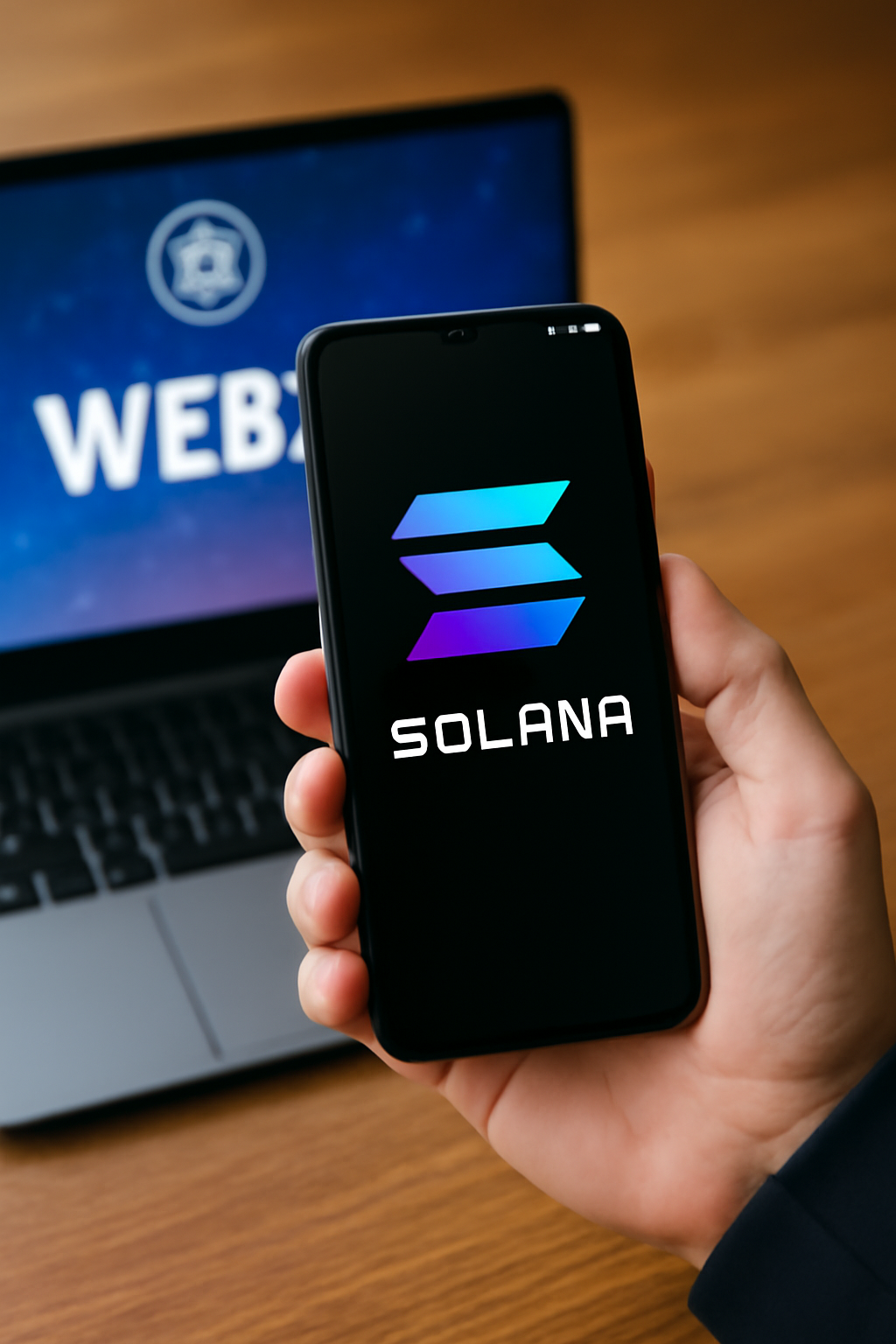The landscape of mobile technology is on the cusp of a profound transformation. On August 4, 2025, Solana Mobile is set to launch the Seeker, its second-generation Web3 smartphone. This device is poised to redefine the intersection of mobile computing and decentralized technologies. With over 150,000 units already pre-ordered globally, the Seeker is generating significant anticipation.
But what makes the Seeker more than just another smartphone? At its core, the Seeker is not merely a device; it’s a gateway to a decentralized mobile ecosystem. It’s a statement that the future of the internet is mobile-first, and that future is decentralized. With its innovative features and infrastructure, the Seeker aims to empower users, developers, and hardware manufacturers alike.
In this article, we will delve into the specifics of the Seeker, exploring its hardware, software, and the underlying technologies that make it a unique player in the mobile space. We’ll examine the Seeker’s features, its decentralized architecture, and the native SKR token that powers its ecosystem. By the end, you’ll have a comprehensive understanding of what the Seeker brings to the table and why it matters in the broader context of Web3 development.
The subsequent sections will provide an in-depth analysis of the Seeker’s hardware specifications, its software ecosystem, the TEEPIN architecture, and the role of the SKR token. Each section will build upon the previous one to offer a holistic view of the Seeker and its place in the evolving mobile landscape.
Solana Seeker: The Definitive Web3 Mobile Device
The Solana Seeker isn’t just another smartphone—it’s a purpose-built device designed to seamlessly integrate the power of blockchain technology into your daily mobile experience. Slated to begin shipping on August 4, 2025, the Seeker is engineered to cater to the needs of crypto enthusiasts, developers, and users seeking a decentralized mobile experience.
Hardware Specifications: Performance Meets Purpose
At the heart of the Seeker lies a robust set of hardware components, chosen to deliver both performance and security:
– Processor: Equipped with the MediaTek Dimensity 7300 octa-core chipset, the Seeker offers a balance between power efficiency and processing capability, ensuring smooth operation for both everyday tasks and demanding applications.
– Memory: With 8 GB of RAM, the Seeker ensures responsive multitasking, allowing users to switch between decentralized applications (dApps) and other tasks without lag.
– Storage: The device comes with 128 GB of UFS 3.1 storage, providing ample space for apps, media, and blockchain-related data, with fast read/write speeds to enhance overall performance.
– Display: Featuring a 6.36-inch AMOLED display with a resolution of 2670×1200 pixels and a 120 Hz refresh rate, the Seeker delivers vibrant visuals and smooth animations, making it ideal for gaming, media consumption, and dApp interactions.
– Battery: The 4500 mAh battery supports wireless charging, ensuring that the Seeker can keep up with the demands of a mobile-first Web3 lifestyle.
– Connectivity: With support for 5G, Bluetooth 5.4, and Wi-Fi 6, the Seeker ensures fast and reliable connections, essential for real-time interactions with blockchain networks and dApps.
This combination of hardware components ensures that the Seeker is not only capable of handling the demands of modern mobile applications but is also optimized for the unique requirements of Web3 technologies.
Software & Ecosystem: A Decentralized Mobile Experience
The Seeker is more than just its hardware; it’s built to provide a comprehensive decentralized mobile experience:
– SeedVault Wallet: A hardware-backed wallet integrated into the device, the SeedVault Wallet securely stores private keys, ensuring that users have full control over their digital assets without relying on third-party services.
– Solana dApp Store 2.0: An upgraded platform for discovering and interacting with decentralized applications, the dApp Store 2.0 offers a curated selection of apps across various categories, including finance, gaming, and social networking.
– Seeker Genesis Token: Each Seeker device generates a unique, non-transferable Genesis Token. This soulbound NFT unlocks exclusive rewards, access, and content within the Solana ecosystem, incentivizing users to engage more deeply with the platform.
– TEEPIN Architecture: The Seeker employs the TEEPIN (Trusted Execution Environment Platform Infrastructure Network) architecture, ensuring that sensitive operations, such as private key management and transaction signing, are conducted in a secure environment, isolated from the rest of the system.
These software components work together to create a cohesive and secure environment for users to interact with the Solana blockchain and its associated decentralized applications.
SKR Token: Fueling the Web3 Mobile Economy
The SKR token serves as the native asset of the Solana Mobile ecosystem, facilitating transactions and incentivizing participation. It aligns the interests of users, developers, and hardware manufacturers, promoting a community-owned digital infrastructure.
By integrating the SKR token into the Seeker, Solana Mobile aims to create a self-sustaining ecosystem where users are rewarded for their engagement, developers are incentivized to build innovative applications, and manufacturers are encouraged to produce high-quality hardware.
Will Web3 Go Mobile-First?
The Seeker represents a significant step towards a mobile-first Web3 future. With over 150,000 units already pre-ordered globally, the demand for a decentralized mobile device is evident. The Seeker’s integration of hardware security features, decentralized applications, and native token support positions it as a compelling choice for users seeking to engage with the Solana ecosystem on the go.
However, the success of the Seeker will depend on several factors:
– Adoption: Widespread adoption of the Seeker and its associated ecosystem is crucial for its success.
– Developer Support: A thriving developer community is essential for creating a diverse range of decentralized applications that meet the needs of users.
– Network Scalability: The underlying Solana blockchain must continue to scale efficiently to handle the increased transaction volume that comes with mobile adoption.
If these factors align, the Seeker could pave the way for a mobile-first Web3 future, where users have full control over their digital identities and assets, all from the convenience of their mobile devices.
TEEPIN Architecture: A Decentralized Mobile Framework
At the core of the Solana Seeker lies TEEPIN—an acronym for Trusted Execution Environment Platform Infrastructure Network. This innovative three-layer architecture is designed to provide a secure, transparent, and decentralized mobile experience, setting the Seeker apart from traditional smartphones.
Layer 1: Hardware — Secure Crypto Hardware with Built-In Trust Protocols
The foundation of TEEPIN’s security lies in the hardware layer. Solana Mobile integrates Trusted Execution Environments (TEEs) into the Seeker’s hardware, ensuring that sensitive operations, such as private key management and transaction signing, occur in a secure enclave. This setup guarantees that even if the device’s operating system is compromised, the integrity of cryptographic operations remains intact. The hardware layer also enables devices to attest to their identity, boot status, and software authenticity, providing verifiable proof of state.
Layer 2: Platform — Verified dApps Meet Authenticated Users
Building upon the secure hardware, the platform layer facilitates interactions between decentralized applications (dApps) and authenticated users. Through on-chain verification, the Seeker ensures that both the device and the dApp are legitimate, eliminating the need for centralized app stores and reducing the risk of malicious applications. This layer also supports verified global distribution, allowing mobile-first dApps to reach users worldwide without excessive restrictions or fees.
Layer 3: Network — A Decentralized Trust Network Spanning Devices and Applications
The network layer introduces a decentralized trust model, where a community of Guardians validates and manages the integrity of the platform. These Guardians are community leaders who oversee the authenticity of devices and applications, ensuring that the ecosystem remains secure and trustworthy. Additionally, the network layer incorporates tokenized platform control, with the native SKR token enabling decentralized ownership of platform access and policy. This approach empowers stakeholders to participate in governance and decision-making processes, fostering a more inclusive and resilient ecosystem.
The SKR Flywheel: Aligning Incentives Across the Ecosystem
Integral to the TEEPIN architecture is the SKR token, which serves as the native asset of the Solana Mobile ecosystem. The SKR token powers the economy, incentives, and ownership across the ecosystem, aligning users, developers, and hardware manufacturers towards growing the Web3 mobile ecosystem.
– Users can earn SKR tokens by interacting with dApps and participating in the Seeker ecosystem.
– Developers are rewarded with SKR tokens based on verified activity and usage of their dApps on the Seeker platform.
– Hardware Manufacturers are incentivized with SKR tokens for integrating Solana’s firmware into their devices, promoting a decentralized, interoperable mobile ecosystem.
This incentive structure not only promotes active participation from all stakeholders but also ensures a self-sustaining economy within the Seeker ecosystem.
Looking Ahead: Decentralizing Hardware and Expanding the Ecosystem
Solana Mobile envisions a future where the TEEPIN architecture is not limited to the Seeker device but extends to a wide range of devices through partnerships with third-party OEMs. By adopting TEEPIN, manufacturers can integrate a Web3 decentralized economy into their devices, offering users a seamless and secure mobile experience. This expansion aims to democratize access to decentralized technologies and accelerate the adoption of Web3 principles in the mobile industry.
In summary, the TEEPIN architecture represents a significant advancement in mobile technology, providing a secure, transparent, and decentralized framework for the Seeker device. By integrating secure hardware, verified platforms, and a decentralized trust network, Solana Mobile is paving the way for a new era of Web3 mobile experiences.
SKR Token: Fueling the Web3 Mobile Economy
The introduction of the SKR token marks a pivotal moment in Solana Mobile’s strategy to decentralize the mobile ecosystem. Designed as the native asset of the Solana Mobile platform, SKR is not merely a utility token but the economic backbone that powers the Seeker device and its associated ecosystem. It serves to incentivize and reward users, developers, and hardware manufacturers who contribute to the growth and enrichment of the ecosystem.
Token Utility and Distribution
SKR’s utility extends across various facets of the Solana Mobile ecosystem:
– User Incentives: Users can earn SKR tokens through active participation within the ecosystem, such as engaging with decentralized applications (dApps), utilizing the SeedVault wallet, and interacting with the Solana dApp Store 2.0.
– Developer Rewards: Developers are incentivized with SKR tokens based on verified application activity, allowing them to retain all revenue generated by their software without intermediary fees.
– Hardware Manufacturer Participation: Hardware suppliers are rewarded with SKR tokens for integrating Solana’s firmware into their devices, promoting a decentralized, interoperable mobile ecosystem.
While the specific tokenomics, including total supply and emission schedule, have not been disclosed, the distribution model emphasizes direct allocation to users and builders based on ecosystem participation.
Integration with TEEPIN Architecture
The SKR token operates within the framework of TEEPIN (Trusted Execution Environment Platform Infrastructure Network), a three-layer decentralized architecture comprising:
– Hardware Layer: Devices attest to their identity, boot status, and software authenticity using Trusted Execution Environments (TEEs), ensuring secure cryptographic operations.
– Platform Layer: Verified dApps interact with authenticated users through on-chain verification, eliminating the need for centralized app stores and reducing the risk of malicious applications.
– Network Layer: A decentralized network of Guardians validates and manages the integrity of the platform, ensuring the authenticity of devices and applications.
In this architecture, SKR facilitates secure, trustless interactions between users, devices, and developers, aligning with Solana Mobile’s vision of a decentralized mobile ecosystem.
Potential Impact on the Mobile Ecosystem
The introduction of SKR, alongside the Seeker device and TEEPIN architecture, positions Solana Mobile to challenge the traditional mobile ecosystem dominated by centralized entities. By integrating blockchain technology, Solana Mobile aims to:
– Empower Users: Provide users with greater control over their data and digital assets, aligning with the principles of decentralization.
– Incentivize Developers: Encourage developers to create innovative dApps without the constraints of centralized app stores, fostering a diverse and open application ecosystem.
– Promote Hardware Innovation: Encourage hardware manufacturers to adopt Solana’s firmware, expanding the reach of the decentralized mobile ecosystem.
While the success of this initiative will depend on widespread adoption, developer support, and the scalability of the Solana network, the integration of SKR represents a significant step towards a mobile-first Web3 future.
In summary, the SKR token is central to the vision of a decentralized mobile ecosystem, providing the economic incentives necessary to drive participation and innovation. Its integration with the Seeker device and TEEPIN architecture underscores Solana Mobile’s commitment to redefining the mobile experience through blockchain technology.
Will Web3 Go Mobile-First? Assessing the Impact of Solana Seeker
The impending launch of the Solana Seeker on August 4, 2025, marks a significant milestone in the evolution of mobile technology. With over 150,000 units already pre-ordered globally, the Seeker is poised to make a substantial impact on the mobile ecosystem.
A Mobile-First Web3 Future
The Seeker is more than just a smartphone; it’s a statement that the future of the internet is mobile-first and decentralized. By integrating Web3 technologies directly into the mobile experience, the Seeker empowers users to take control of their digital identities and assets. Features like the SeedVault wallet and the Solana dApp Store 2.0 provide a seamless interface for interacting with decentralized applications, while the SKR token incentivizes participation and fosters a thriving ecosystem.
Market Demand and Adoption
The strong demand for the Seeker, evidenced by the substantial number of pre-orders, indicates a growing interest in Web3-integrated mobile devices. This demand suggests that users are ready for a shift towards mobile-first Web3 experiences, where they can engage with decentralized applications and manage their digital assets directly from their smartphones.
Developer Opportunities
For developers, the Seeker offers a platform to build and distribute decentralized applications without the constraints of traditional app stores. The Solana dApp Store 2.0 provides a curated environment for dApps, ensuring quality and security. Additionally, the SKR token offers a novel incentive structure, aligning the interests of developers, users, and hardware manufacturers.
Challenges and Considerations
While the Seeker presents numerous opportunities, there are challenges to consider. The success of the Seeker will depend on widespread adoption, developer support, and the scalability of the Solana network. Ensuring that the device meets the diverse needs of users and developers will be crucial for its success.
Looking Ahead
The launch of the Seeker represents a significant step towards a mobile-first Web3 future. By integrating Web3 technologies into the mobile experience, the Seeker has the potential to transform how users interact with the internet, manage their digital identities, and engage with decentralized applications.
The Dawn of a Mobile-First Web3 Era
The impending launch of the Solana Seeker on August 4, 2025, signifies more than just the release of another smartphone. It marks a pivotal moment in the evolution of mobile technology, where decentralization, user sovereignty, and blockchain integration converge to redefine the mobile experience.
A New Paradigm in Mobile Technology
The Seeker is not merely a device; it embodies a comprehensive ecosystem designed to empower users, developers, and hardware manufacturers within a decentralized framework. At its core lies the TEEPIN architecture—a three-layered system encompassing hardware, platform, and network layers—that ensures trust is verified through cryptographic means rather than centralized authorities. This approach fosters an open, secure, and transparent environment for all stakeholders.
Complementing this architecture is the introduction of the SKR token, the native asset of the Solana Mobile ecosystem. The SKR token facilitates transactions, incentivizes participation, and aligns the interests of users, developers, and hardware manufacturers, promoting a community-owned digital infrastructure.
Global Impact and Adoption
With over 150,000 units pre-ordered globally, the Seeker has garnered significant interest, indicating a strong demand for decentralized mobile solutions. This widespread adoption underscores the growing recognition of the need for user-centric, blockchain-integrated mobile devices.
The Seeker’s integration of features like the SeedVault Wallet, Solana dApp Store 2.0, and Seeker Genesis Token further enhances its appeal, offering users a seamless interface to interact with decentralized applications and manage their digital assets securely.
Challenges and Considerations
While the Seeker presents numerous opportunities, several challenges must be addressed to ensure its success:
– Adoption and Network Effects: Widespread adoption is crucial for the Seeker’s success. The network effects of a decentralized mobile ecosystem depend on the active participation of users, developers, and hardware manufacturers.
– Developer Ecosystem: A thriving developer ecosystem is essential for creating a diverse range of decentralized applications that meet the needs of users. Solana Mobile’s efforts to provide incentives and support for developers will be critical in this regard.
– Scalability and Performance: Ensuring the scalability and performance of the Solana network is vital to accommodate the increased transaction volume resulting from the Seeker’s adoption. Continuous improvements to the network’s infrastructure will be necessary to support this growth.
Looking Ahead
The Seeker represents a significant step toward a mobile-first Web3 future. By integrating blockchain technology into the mobile experience, the Seeker has the potential to transform how users interact with the internet, manage their digital identities, and engage with decentralized applications.
As the mobile ecosystem continues to evolve, the principles of decentralization, user sovereignty, and open innovation will play an increasingly important role. The Seeker, with its innovative features and decentralized architecture, positions itself as a catalyst for this transformation, paving the way for a more open and user-centric mobile future.





